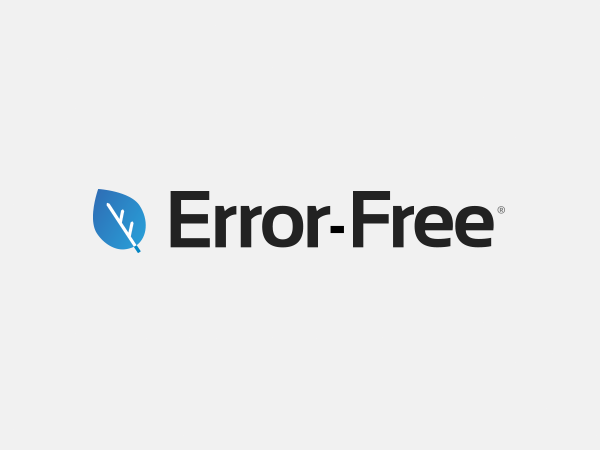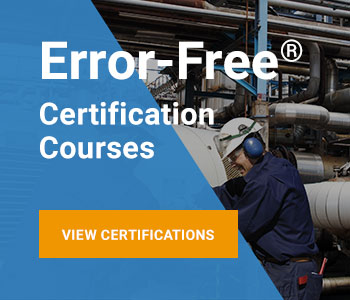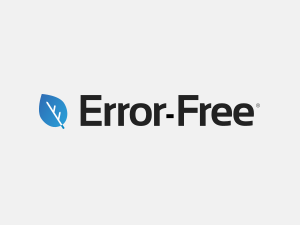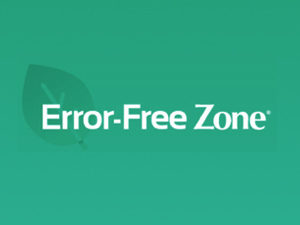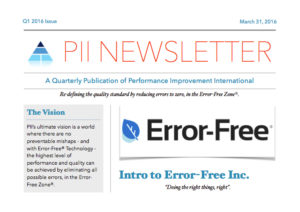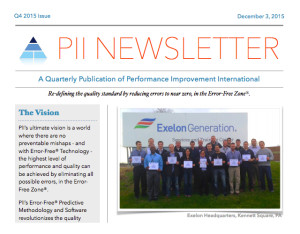Error-Free® human performance cannot be achieved by using the same level of thinking that created human performance problems in the first place.
Over the past 30 years, more than 50 human and organizational performance experts have worked with Dr. Chong Chiu, Founder of PII and MIT PhD, to achieve a goal that could benefit all of humanity – Error-Free® human performance. This goal has now been achieved. These new technologies have been proven to work well at many places; including, one of the largest construction firms, one of the largest nuclear operating companies, and one of the largest vaccine manufacturing companies in the world. This short paper serves to give an overview and describe the basic elements of these new technologies.
The following short paper is divided into two parts. The first part is related to technologies applied to an individual to achieve Error-Free® status without the help from their organization. The second part is related to technologies for an organization to obtain Error-Free® Operation and Human Performance. It often takes effort described in both parts to get the instant human performance improvement for a large organization.
Part 1: Error-Free® Human Performance – Individual Perspective
Error-Free® human performance is when an individual (an employee, a manager, or an executive) makes no errors in tasks s/he is responsible to perform. Error is defined as a sub-standard action that has negative consequences. A near miss is a substandard action that has a possibility to cause negative consequences.
Why do we err?
Human beings are bound to err. This phenomenon is not new, but has been known to exist since the beginning of human civilization. Many historians even assert that we make the same kinds and same levels of error repetitively over the span of civilization. Error rates, as measured by man-made disasters, are actually slightly increasing over the generations.
Since childhood, we are taught history lessons in the hopes we improve our errors rates from lessons learned. But, why do we not learn from these history lessons? Even after generation after generation?
The short answer: Based on decade long research, humans are pre-programmed to make errors, partially owing to our genes and partially owing to the upbringing process. This pre-programing repeats itself generation after generation.
PII’s research found that there are two groups of factors affecting how we make errors: (1) in-born factors and (2) forming factors. In-born factors relate to genetic attributes. Forming factors relate to environmental attributes since childhood.
We are born with limitations in memory decay and attention span. We are often asked to remember too many things for too long a period time without prompting. We are also often asked to do jobs that require an attention span much greater than our born capabilities.
Also, we are born with brain diversities too. Some can have difficulty reading a map, while others may have difficulty following line-by-line instructions.
Upbringing can also affect how we make errors. For example, we are taught by our parents in our childhood to listen to them and our teachers (“authoritative figures”). As we grow up, we are programmed to trust the information given to us by authoritative figures, like so-called experts, management, and popular TV characters. Often times, we make mistakes from listening to and being influenced by these “authoritative figures” without question.
Pre-programming, constructed from in-born factors and forming factors, that cause humans to make errors is just one facet of why we err. The other facet is the existence of high-risk situations (or called error traps) that induce errors. One example of an error trap is time pressure.
PII’s research has found that these high-risk situations or error traps can be divided into four categories: time related, activity related, people related, and environment related.
Past Approach for Human Performance Improvement
In the past, many companies have attempted to improve human performance by identifying and mitigating non-people oriented error traps (e.g. working hours, time pressure, etc.). This approach, however, has mixed results. Statistical data for the past 20 years have found that this approach may help initially, but does not have results that last.
Past approach has one key problem. It does not account for the biggest factor that induces error. That factor, is, ME. Yes, “me”, the individual.
PII’s research found that the areas of error proneness are individual specific due to in-born and forming factors. One may be prone to make errors from drowsiness. Others may be prone to make errors from distractions. Unless the approach is individually tailored and has a time prompting, the shot-gun approach to ask all workers to watch out for “all” error traps “all” the time is just not practical. Actually, it is beyond one’s capability to do so.
The Breakthrough – Daily Improvement Towards “Error-Free® Status”
To achieve an Error-Free® status from an individual perspective, the individual has to know their own vulnerable areas. These areas can be self-inspected in four areas:
- Capabilities
- Attitude
- Personality
- Experience
The identified vulnerable areas should be compensated for. For example, if we feel the task at hand is beyond our capabilities in some aspects, it is better to seek out wisdom somewhere and learn it. Or, if the task at hand is related to communication and our personalities are not up for it, it is better to follow a good communication protocol to avoid communication errors.
Error-Free® Readiness and Reflection
PII’s research found that unless one could repeatedly inspect their own “readiness” to be error free and reflect on those “results” of how to improve to be error free, a person would not be able to achieve “error free”. Achieving this goal is a continuous improvement cycle.
Repeatedly inspecting our own readiness and results are key elements to achieving Error-Free® status. “Repeatedly” means before taking on a new job or new task, and even just on a daily basis. The “readiness” and “result” is like a continuous improvement cycle, showing our self on a task-by-task basis or on a daily basis how well we will do.
Error-Free® Readiness and Results Meters
Our research found that routine tracking of Readiness and Reflection is important to keep one focused on the goal. The goal is 100% ready and 100% error free results for all tasks every day.
Also, like a fitness calculator, tracking is most effective when it is quantitatively shown so that progress is very readable, understandable, and actionable. As such, PII developed two independent meters. One is the “Error-Free Readiness” meter; the other is the “Error-Free Results” meter. One is used before the task or start of the day; the other is used after the task and after the day.
What is the Error-Free® readiness meter?
The Error-Free® readiness meter consists of two sets of 4×4 (16) questions. One set deals with four areas in individual error vulnerabilities: Capabilities, Attitude, Personality, and Experience. The other set deals with four areas in high-risk situations: Time Related, Activity Related, People Related, and Environment Related. The questions are formatted and posed to an individual who is ready to embark a task or a new day, “Are you ready to deal with the error risk ahead of you?” If the answers in all areas are “yes”, this individual is 100% ready to be Error-Free®. In the cases where some answers are “no”, if the individual takes compensatory actions, they can also be considered “100%” ready.
If the readiness score is too low, one could choose to take some compensatory actions to increase the level of readiness.
What is Error-Free® results meter?
The results meter reflects the results after the task. It is a self-assessment about how many errors (or less than adequate actions) in the four areas high risk situations. If there are no near-misses and no error, it is 100% error-free. If there is a near miss or an error(s), the result meter would examine two possibilities. One is that the risk is not identified; the other is that risk is identified, but not compensated. If the risk is not identified, then the lessons to be learned is to improve one’s sensitivity to risk. If the risk is identified but not compensated for, the lessons to be learned is to learn how to improve or compensate for vulnerable areas.
The results meter is a critical self-assessment. During the assessment, any action that could be performed better, faster, and less problematic, could be considered as a near miss.
Part 2 – Error-Free Operation and Human Performance- Organizational Perspective
Error Free Operation and Human Performance
Error-free operation and human performance mean no operational or injury events due to preventable human errors.
The concept of the error-free operation and human performance is hard to conceive, under which the operation is free of operator errors, maintenance rework, engineering design and problem solving errors, and decision errors from management. How can that be done?
Is that possible to have error free operation and human performance without prohibitive costs? The costs could be on training, setting up many barriers, or just hiring workers don’t make errors.
The short answer is yes. Two new PII technologies: (1) Predictive Quality, (2) KALETM Error-Free® Intelligence Software has made Error-Free® operation and human performance possible.
Predictive Quality
Predictive quality is a paradigm shift from reactive quality, which is largely embedded in our current management system, all the way to the other extreme end of proactive quality.
We certainly remember the management motto,
If you cannot predict, you cannot focus.
If you cannot focus, you cannot measure.
If you cannot measure, you cannot improve.
This motto eloquently summarizes the dilemma of reactive quality. Reactive quality can only rely on events and root cause analyses to find problems. It does not possess the foresight and capability to predict and prevent events ahead of time.
In the past, human errors were largely treated as a necessary evil. As a consequence, we tried to train staff how to identify and avoid error traps. Over time, employees forgot this training and fell back into habitual behavior they are used to. Another reactionary effort is to set up multiple barriers in an attempt to catch and correct errors, also known as Layers of Protection (e.g. technical review, behavior guiding procedures, etc.). Administrative staff is then tasked with setting up these barriers. However, they do so without considering their functional effectiveness and failure rates; these barriers fail miserably with time. Worse yet, when events occur, extensive and expensive root cause analyses are required. The results from these root cause analyses are often limited to teaching staff, again, with the same training they couldn’t remember initially and to writing more ineffective procedures in the same way that caused failure the first time. This event-driven reactive cycle can continue without improvement in operation for many, many years.
This sluggish improvement cycle, mentioned above, caused from reactive quality methodology can be effectively rectified. How? The answer is by shifting from reactive to predictive in quality.
The center point of predictive quality is a quantitative prediction of management system failure rates and individual human errors, about how, what, when, and where failure and error will occur.
Using a quantitative approach, human error and management failure is predicted and identified (as confirmed by past events), then allowing the critical controlling parameters affecting errors to measure to be found. Once found and able to measure, these controlling parameters can be effectively and readily improved. Moreover, after events, the predictive quality can prioritize the topics in training, improvements in barriers, and corrective actions. Based on quantitative analysis, only the most effective are chosen for implementation, leaving those least effective aside, saving time and cost.
The predictive quality process. Before we set up a barrier to prevent events, we design these barriers as we design equipment (e.g. a transformer, a turbine, etc.). We predict the failure rate and error rate that trigger events before the design and make sure they are acceptable after the design. As such, they are effective, not just in abundance, in preventing events. For workers, since we understand limitations in memory decay and tendency to make errors in certain conditions, we provide them the right information at the right time to warn them about imminent error traps and help them avoid errors.
To affect culture changes, PII has customized Error-Free® training courses; from Error-Free® Review, Error-Free® Procedure Design to Error-Free® Leadership in order to indoctrinate the predictive quality concept and its implementation process.
KALETM – An Error-Free® Intelligence Software
KALETM stands for the names of its four main modules: Knowledge, Analysis, Learning, and Error-Free® Data Bank.
KALETM is a cloud-based Error-Free® intelligence software, accessible by all devices and operating systems. This Error-Free® integrated tool provides the right information, the right check list, the right procedures, and the right analysis as a SAAS solution to help staff avoid errors or to find root causes of their errors in the most cost-effective way.
For example, KALETM can help staff avoid errors in the following ways:
- KALETM can provide e-learning on how to avoid error, on a daily basis from about error avoidance in that KALETM has one of the largest case studies library about how, when, and what errors are made and are mitigated.
- KALETM can provide e-learning in equipment reliability in that KALETM has one of the largest database about how, why, and when components could fail.
- KALETM is a cloud-based software and can provide procedures and references on an ad hoc basis, retrieved at anytime and anywhere.
- KALETM can help workers analyze themselves to their person-specific error-prone behavior
- KALETM can tell the risk of error at the pre-job-briefing based on worker-specific, job-specific, and environmental conditions.
- KALETM can audio record pre-job-briefings and analyze the readiness of the pre-job briefing.
- KALETM can help workers perform human error Root Cause Analysis and Organizational and Programmatic Root Cause Analysis through a series of Questions-Answers. Not only the analyses can be performed consistently and with high quality, KALETM can write and print out root cause reports, providing consistent and direct reporting.
- KALETM can help workers perform equipment troubleshooting through a series of Questions-Answers. After the series of Questions and Answers are answered, KALETM constructs a report for troubleshooters.
KALETM is a living system. Even though its capability and database are beyond what once seemed unfathomable, its database continues to grow and build with new events, research, analysis, and findings, regardless where they occur, in human and equipment reliability.
Benefits of Error-Free Operation and Human Performance
The ultimate vision and goal of establishing an Error-Free® operation and human performance everywhere, is to better not only individual lives in the workplace, but for humanity. The operation event rate and injury rate could go to near zero, instantly. Moreover, the operation and maintenance (O&M) cost in operation could drop significantly in the following areas:
- Repeat, unfocused error-reduction training
- Multiple barriers that should be simplified
- High event rate, each of which waste effort in management, regulatory staff, and operation staff to address
- Unneeded corrective actions, with little (or no) benefits
- Long and tedious human performance and O&P root cause analyses
- Long and tedious equipment troubleshooting
- Untimely troubleshooting in equipment or human performance issues, allowing them to progress into significant events
Knowing that even for a very standardized industry, the O&M costs of operation from company to company varies +/- 20%, largely depending on levels of human performance. Moving to an Error-Free® operation and human performance will benefit a company with a minimum of 15% O&M cost savings and will also benefit from establishing a company’s reputation as being “error free”. The speed and magnitude of O&M cost savings can be realized depending on the level of management commitment to predictive quality and Error-Free® intelligence software. We have seen fast improvement results at some organizations within a year. For a larger company, 3-5 years is a reasonable time frame to achieve that money saving goal.
With predictive quality and the KALETM, an organization can become error free, almost instantly. Before these technologies, we had to wait for significant events to occur and only then, perform root cause analyses to improve the operation. As stated before, this improvement is usually not focused and does not quantify the benefits of each factor considered. We tend to think that if we improve all areas, we will be good. This approach is burdensome. Over time, the burden we add onto the management system make companies very costly to operate. Moreover, the event-driven improvement cycle is very slow, even if it works.
Now, with predictive quality, we prevent events from the get-go and take a focused approach to improve only the few critical areas that are the most effective in establishing an Error-Free® Operation and Human Performance.
Also, with the complementary tool, KALETM, built to help predict quality, all workers can avoid and learn from errors cost effectively.

